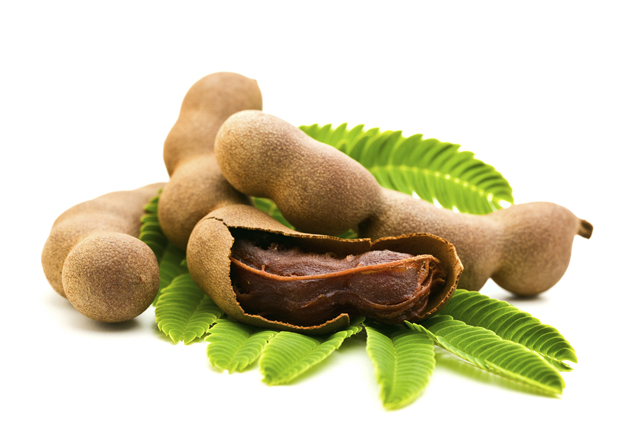It’s a condiment. It’s a spice. No, it’s a bean. The “Manila sweet,” as the tamarind is sometimes called, is all of the above. Tamarind or ‘tambran’ as it is affectionately called in Trini parlance, is a natural food of South Asia and is said to be native to Africa. It melodic name comes from the Persian ‘tamar-I-hind’, meaning ‘date of India’.
‘Tambran balls’ evoke fond childhood memories for most Trinidadian adults, and despite the influx of other snacks that have been imported to the country over the past few decades, ‘tambran balls’ are still well loved and cherished today.
Tamarind trees produce an abundance of long, curved, brown pods filled with small brown seeds, surrounded by a sticky pulp that dehydrates naturally to a sticky paste. Processed tamarind products can be found in supermarkets, but remember that additives can alter the nutritional profile. It’s better to purchase tamarind when it is fresh and still in the pod. Refrigeration is the best way to preserve the freshness for up to several months.
Tamarind has a long history of medicinal uses. Many involve easing stomach discomfort, aiding digestion, and use as a laxative. Tamarind preparations are used for fevers, sore throat, rheumatism, inflammation, and sunstroke. Dried or boiled tamarind leaves and flowers are made into poultices for swollen joints, sprains, boils, hemorrhoids, and conjunctivitis.
Tamarind Nutrition Facts
Serving Size: 100 grams of tamarind
Amt. per serving
Calories: 239
Carbohydrates: 62 g
Fibre: 5 g
Protein: 3 g
Each 100 grams of tamarind contain 36% of the thiamin, 35% of the iron, 23% of magnesium and 16% of the phosphorus recommended for a day’s worth of nutrition. Other prominent nutrients include niacin, calcium, vitamin C, copper, and pyridoxine.
However, consume tamarind in moderation because it contains fructose, which may be harmful to your health in excessive amounts.
Studies on Tamarind
Tamarind is known to be useful in traditional medicine for diabetes and obesity. Its high levels of polyphenols and flavonoids may increase glucose uptake in such patients.
In another study, many of the traditional medical uses for phytochemical-rich tamarind extracts were reported by researchers as useful in modern medicine as well. Successful therapies included: abdominal pain, diarrhea, dysentery, parasitic infections, fevers, constipation, inflammation, gonorrhea, and eye diseases.
Tamarind extracts were also reported to be antimicrobial, anti-venom, antioxidant, wound healing, and effective against diabetes, malaria, and asthma.
Tamarind Healthy Recipes:
Coconut and Tamarind Chicken Curry
Ingredients:
- 10 skinless, boneless chicken breasts and thighs
- Juice of 2 limes
- 1 tsp. coarsely ground black pepper
- 1 tsp. turmeric
- 3 Tbsp. coconut oil
- 2 Tbsp. tamarind pulp
- ¾ cups coconut milk
- 1/3 cup (1 can) coconut cream
- 1 Tbsp. chopped or dried coriander
For the Sauce:
- 2-4 Tbsp. coconut oil
- 1½ tsp. mustard seeds
- 1½ Tbsp. fresh or dried curry leaves (opt.)
- 2 onions, finely diced
- 3 garlic cloves, crushed
- 2½ Tbsp. minced ginger
- ½ Tbsp. paprika
- Chopped tomatoes (equivalent to 2 small canned tomatoes)
- A few Tbsps. chicken or vegetable stock
- 1 Tbsp. golden muscovado sugar or raw brown sugar
Procedure:
- Mix lime juice, pepper, and turmeric in a large bowl. Coat chicken with this mixture.
- Heat oil in a large skillet. Add mustard seeds, curry leaves, and onions. Stir, cover, and cook on low for 10 to 15 minutes, stirring occasionally.
- Add garlic and ginger, increase heat, and stir in paprika, tomatoes, stock, raw sugar, and dried curry leaves (if using). Cook uncovered for 15 to 20 minutes until sauce has thickened and reduced.
- Preheat oven to 325 degrees Fahrenheit. Heat oil in a skillet and fry chicken until golden. Pour excess oil from frying pan and let cool slightly. Add ½ cup of water to skillet, stir, and use a spatula to add the juice to tomato sauce.
- Place chicken in a roasting pan, pour sauce over it, and then cover and bake for 15 minutes or until chicken is tender.
- Transfer chicken to a serving dish. Place stovetop safe roasting pan on stove on low heat, bring to a simmer, and stir in tamarind pulp, coconut milk, and half the coconut cream. Ladle over chicken, drizzle with remaining coconut cream, and sprinkle with coriander before serving.

